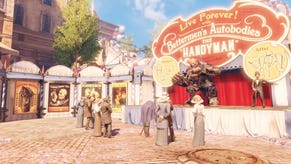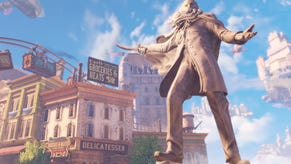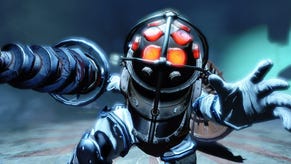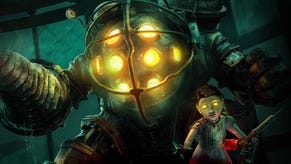Interview - Irrational Games' Ken Levine
Shown to press in New York last week, BioShock Infinite is a first-person shooter set in 1912 from Irrational Games and Ken Levine - one of the masterminds behind our first venture into Rapture with BioShock 1.
Ken Levine is on-hand at gamescom this week, chatting to the press about Infinite, and Keza MacDonald was given the opportunity to speak with him on our behalf.
This time, Levine and company are taking us to skies, in a game Keza describes as "breathtaking, vertiginous and invigoratingly surprising".
Below the page fold is the interview in it's entirety, where Levine tells us how Irrational doesn't think of "Infinite as BioShock 3”, yet it's still "totally a BioShock game".
[Interview by Keza Macdonald]
VG247: You've been working in secret now for two and a half years – how difficult was it to keep the secret?
Ken Levine: We're an organisation that makes games, not one designed to keep top secret secrets, and so we constantly had to be checking ourselves. Even at the recent event in New York, we had these gift bags to give out with various items from the game, and we thought alright, we'll just leave them under the seats – and then we couldn't because someone might have seen them before the event. We always had to think about security procedures; we had a codename for the game in case emails got leaked. It was complicated because that's not what we do – we're not the CIA. But we managed to do it – we're really happy that as many people as we could saw that trailer without knowing what they were seeing.
VG247: BioShock the first was very much a new way of telling a story through the FPS. What has FPS storytelling got left to explore?
Ken Levine: It's hard for me to speak as the industry, but for us at Irrational, you can't just do the thing you did a few years ago and expect it to have the same impact. It's so easy to think of sequels as “Here's five new monsters, here's five new levels”, and that's absolutely not how we wanted our studio to approach a new BioShock game. We thought, what are all the things we are excited about in first person shooters, and what are the things that we think are getting long in the tooth, that the genre is relying upon? For us it was, “Hey, there's a dude on the other side of a glass window who gives you your mission”, or “There's a guy in my ear telling me my missions by radio”.
That's where Elizabeth came from. We thought, we're going to have a character who you care about, right there. People have done that before, but the challenge with doing it in a BioShock game was, firstly, how are her powers going to fit with yours – because we never want her powers to be in charge of the action, the player has to be in power, but we wanted her to have an impactful presence in the game. And secondly, because BioShock games tend to feel more grounded in humanity, you feel that there are people living in this place who are affected by what happens here, but you are also being thrown into an environment that's specifically designed for shooting people, so making her believable and making the player connect with her is really important to us. She's a big part of the storytelling.
The fact that you're a character this time is also a big part of the storytelling – it doesn't sound like a big thing, but in BioShock the fact that you were a cipher was critical to the story, whereas here the fact that you are Booker DeWitt is critical to the story. That's been a challenge for us.
You've said before that Irrational's new project was a new IP – why use the BioShock title?
Levine: We never thought of it as BioShock 3, as a follow-on to BioShock 2, but at the same time it is totally a BioShock game. We look at BioShock games differently, as the guys who created it. Here's why we believe this is a BioShock game: it's set in a world that's ridiculous and fantastical and over the top, but still connected to the human experience very much. It feels like it could be a real place. The second thing is that you have this suite of powers so that you drive how you play the game, as much as you can. And you can really see that in the demo – you've got the weapon in one hand and the powers in the other hand, and you really decide how you fight the battles. And also the world of Columbia, that feels connected – there's a real human endeavour going on there.
For us, that is a BioShock game. Everything else – the location, Big Daddies, Little Sisters, all those things that seem so iconic – that is underneath what I mentioned in the hierarchy, in terms of what's important to make BioShock game. I think it was never just about Rapture. It's about a certain dynamic that we wanted to continue to explore. And if we had made something that had those components and wasn’t a BioShock game, I think people would be asking us, well, why isn't this called BioShock? It feels so similar. And that's our mission – to make something that feels familiar but which is different at the same time.
It would appear from the demo that there's more emphasis on powers and less on bullets this time around. Would that be fair to say?
The demo is designed specifically to show what is different about this game compared to the previous games. It's a very specific experience, you know – ten minutes – to get all those ideas across. I mean, you're on the skylines, you're dealing with crowds of fifteen people, you're shooting guys from half a mile away – you don't see a lot of traditional BioShock spaces, but that's not say there won't be any. There will be. You'll have these tense moments, those quiet spaces, but there's a tonne of action in the demo. It's not a sample just thrown out of the game, it's there to illustrate the differences.
It seemed that BioShock communicated on different levels in its marketing, which focussed on wasting dudes with awesome powers, and then when you were actually playing the game, which was considerably more intelligent. Will this be the same for Infinite, and did you find that frustrating?
There's two audiences out there that you're trying to reach when you make a game like BioShock. One is game critics, hardcore gamers, who you can speak to in a way that's more sophisticated than how you can speak to a rawer audience. There are people who are enthusiasts – me, you, the gamers – and you can use the shorthand with them. You can talk about hybrids – you can say, yeah, it's got RPG elements, it's an RGP-FPS, and this is an adventure game element, and they understand. You say that to most people and they're like, whuuut? What are you talking about dude?
The example I always use is Oreo cookies – people love those, and in America every season they have a different variety. I'll go into the store and see the Halloween cookie and go, oh cool, it's orange, but I don't go on blogs and read about the cookies ahead of time, I just see it in the store and buy it. I'm sure there are people who think about cookies in advance, too. But you have to address both those audiences.
Sometimes you try to describe it in a language that's acceptable to that larger audience, so that they understand what they're getting. We had this experience with System Shock 2 where we only spoke to the hardcore audience in terms of how we positioned the game and how we marketed it. I think that this time, when we talk to the press we can talk about it in a much deeper and more sophisticated way, but in terms of the ads for the game and stuff like that, it'll be much more focussed on the action, to reach a broader audience. But we definitely understand that there is a huge and important audience that you can speak to in great detail about the game.
The game's propaganda and proto-fascistic art is striking – where did that idea come from?
It's a great way to communicate ideas visually. Characters talking about ideas is one thing, but communicating those ideas through a visual medium is another thing. This period is the golden age of illustration, where illustration really came into its own. The notions of this propaganda... it was such a formative time for illustration that the methods don’t seem so subtle any more, but back at the time, that was really subtle. I've always enjoyed looking at propaganda posters and constructivist paintings, the way they get their ideas across. It's like when you look at a Korean ad nowadays – because they're such a hermit society, they didn't have all the media exposure that we did, so you look at their propaganda now and it's crude and obvious to us. But to them it's incredibly effective. It's like this poster behind me, here (he points at a Columbian reworking of the iconic “Daddy, what did you do in the Great War?” – it's really effective, you've got the kid asking her dad what he did in the war and the shame on his face, his shame at not having taken part, it still kinda works to that effect. I've known this poster since I was a kid and it's just a striking image, and there's so much great illustration from that time.
How does the variety of the locations – outside, skylines, broad open spaces – change the design of the game?
I think that our goal here was to have a broader range of spaces. In the first BioShock you had a lot of tight quarters, a lot of coming around a corner to fight one or two guys in a tight space. And the problem with that is that you're always asking for the same thing from the player – you know the expression, when all you have is a hammer, everything looks like a nail? The electro bolt and the shotgun was the most effective combination because it's one or two guys, right in front of you.
But if you try to use the shotgun out there [in Columbia], it's not going to do you much good. If you try to use a sniper rifle on someone doing 80 miles per hour on a skyline, that's not going to do you much good. So we want to demand more of the player's tool set. In BioShock 1, nobody would have cared about a crown control weapon – it's not that useful because you never encountered crowds. Here you're facing 15 people at once. So the environment is both a way for us to be visually striking and a way to ask different things of the player.
What you'll see is interesting pacing – you'll be flying along on a skyline and jump off and suddenly you'll go inside and it's quiet, it's dark and it's intimate, and you're sneaking around, we're visually telling the story and you're learning about what's going on in the world, and then you get into combat in a dark room with one guy, and then you'll run outside and there's ten guys coming at you from the skylines, and then you're on the skylines, like a roller coaster on top of a roller coaster on top of a roller coaster, jumping between all these different levels, and you're shooting at guys and they're shooting at you, and then you're back indoors, and it's quiet again – that's about pacing. It's critically important. And these new environments just expand our power. We're not replacing what we did before – we're expanding.
BioShock Infnite is slated for PC, PS3, and Xbox 360 in 2012. Catch our hands-on preview here.










